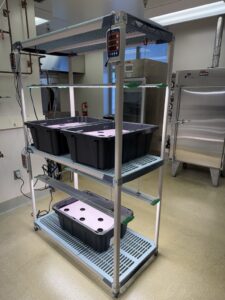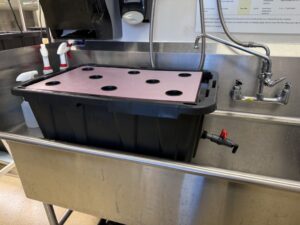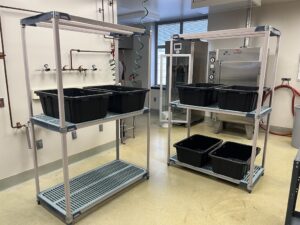Progress report for GNE24-334
Project Information
Hydroponic farming continues to grow in popularity. Recent
outbreaks linked to hydroponic produce highlight the need for
improved understanding of how foodborne pathogens persist in
these systems and provide a way to control them. The aim of this
proposal is to (i) study the persistence of
Salmonella, E. coli, and Listeria, in two types
of hydroponic systems (deep water culture and Kratky) and to
(ii) assess the efficacy of PAA as a pathogen
control strategy. In the first objective of this project,
pathogens will be inoculated into water to assess their
persistence. In the second objective of this project, pathogen
control interventions will be assessed to reduce food safety risk
while maintaining, or promoting, plant health and productivity. I
hypothesize that under conditions where biofilms do not form, the
Salmonella and E. coli strains will persist for
two weeks, while the Listeria strains will persist for
one week as suggested by a previous study (Ilec et al., 2022). I
also hypothesize that a treatment of 80ppm PAA for 30 minutes
will reduce pathogen load. The findings from this project will
help understand the microbial risks and how to manage them in
hydroponic farms. Findings will be disseminated among Northeast
hydroponic farmers and beyond through the Mid-Atlantic Fruit and
Vegetable Convention.
Objective 1: Evaluate the persistence of Salmonella,
E. coli and L. monocytogenes in hydroponic
systems.
Expected outcome: Characterization of
Salmonella, E. coli and Listeria persistence in
hydroponic systems in a controlled laboratory setting.
Deliverables: Spreadsheet and graphs with
concentrations of Salmonella, E. coli and L.
monocytogenes in a nutrient solution over the growing period
and the final harvested produce grown in the DWC and Kratky
hydroponic systems.
Potential pitfalls and alternative approaches:
We plan to inoculate leafy greens seeds with an inoculum at
108 CFU/ml of Salmonella, E. coli and L.
monocytogenes. If this inoculum level leads to
concentrations of pathogens that are below the limit of detection
of our microbial detection methods, we will collect a larger
volume of a sample and filter it in order to obtain quantities of
pathogens.
Objective 2: Assess pathogen control steps aimed at
reducing pathogens on seeds
Expected outcome: Developed and assessed
pathogen control step for seeds that is accessible and feasible
for hydroponic farmers to implement to reduce the risk of
introducing Salmonella, E. coli and L.
monocytogenes contamination in hydroponic systems.
Deliverables: A mitigation step made publicly
available to hydroponic farmers in the NE region through a
publication and communication at the Mid-Atlantic Fruit and
Vegetable Convention.
Potential pitfalls and alternative approaches:
If the mitigation step negatively impacts seed germination, plant
growth or plant quality, we will evaluate alternative methods to
control bacterial growth. Preliminary small-scale experiments
will be conducted to assess these factors.
The purpose of this project is to investigate the persistence and control of bacterial foodborne pathogens in deep water culture (DWC) and Kratky hydroponic farming systems. Hydroponic farming is estimated to grow another 12.4% from 2024 to 2030 (Grand View Research.,2024). Hydroponic farming can reuse water and be done in urban areas where it is often more difficult to grow and access fresh produce (Zhen,2021). Hydroponic farming helps increase sustainability through water conservation, reduction of greenhouse emissions, and minimal use of chemicals (Pomoni et al.,2023). Despite these benefits, limited research has been conducted on how bacterial foodborne pathogens behave in these systems.
The DWC and Kratky systems consist of a water reservoir with a raft to support the plants during growth. The DWC has a pump to oxygenate the nutrient solution, while the Kratky system does not. The Kratky system is an easy adaptation from the DWC system allowing more data to be collected with no additional setup costs. BrightFarms, Gotham Greens, and Greens Do Good in the Northeast region the DWC technique.
There are gaps in hydroponic research. One study assessed the survival of Salmonella Typhimurium and Listeria monocytogenes in the nutrient film technique (NFT) hydroponic system (Ilic et al.,2022), while others assessed E. coli and Salmonella in a deep flow technique (DFT) system (Shaw et al.,2016; Xylia et al.,2022; Li et al.,2022). To the best of our knowledge, the persistence of foodborne pathogens has not yet been investigated in the Kratky or DWC system. Our proposed project therefore aims to fill this gap in knowledge by studying the persistence and control of Salmonella, E. coli, and Listeria monocytogenes in the DWC and Kratky systems.
As hydroponic farming continues to grow in popularity, we must understand the associated food safety risks. Foodborne pathogens Salmonella, E. coli, and L. monocytogenes have previously been found in produce grown in hydroponic farms (FDA; McClure et al.,2023; Wang et al.,2020). Furthermore, they have been shown to spread, form biofilms, and be taken up and attached to plants (Riggio et al.,2019; Hirneisen et al.,2012; Kyere et al.,2020). If hydroponic farming is to safely advance, we need to improve the understanding of how these bacteria behave in these hydroponic systems to develop effective control strategies.
It's important to understand how hydroponic systems can be contaminated. Peat moss plugs, used for germination, have been a hot spot for bacterial growth in hydroponic systems (Dankwa et al.,2019). The seed germination environment has high water and nutrient retention providing an environment conducive to bacterial growth. If contaminated seeds enter the facility, the contaminants can multiply in the germination area and spread rapidly in the enclosed hydroponic system (Saldinger et al.,2023).
We propose to use peracetic acid (PAA) as our intervention to control pathogens. PAA has a half-life of 22 minutes and doesn’t leave residues like other chemical treatments. Hydroponic farming reduces the need for harsh chemicals, an aspect we tried to preserve for this proposal. The maximum concentration of PAA allowed for produce contact according to the USDA is 80 ppm. This regulation, along with the half-life, is why we chose to use 80 ppm of PAA for 30 minutes as our intervention.
We will set up a hydroponic system inside a biosafety level-2 food safety pilot plant, a state-of-the-art facility at Penn State that is available for controlled food safety experiments. Our experimental design will include six replicate hydroponic units with a flexible design that can be used for DWC and Kratky setups. Leafy green seeds will be inoculated with a bacterial cocktail of E. coli, Salmonella, and Listeria. The contaminated seeds will be germinated and planted into all six hydroponic system replicates. Three of the systems will be used for an assessment of PAA intervention at the seed level while the other three serve as positive controls. One type of hydroponic system at a time will be assessed. The ambient temperature and humidity will be controlled to mimic commercial indoor growing facilities.
After planting, the nutrient solution, plants, and roots be sampled. E. coli, Salmonella, and Listeria will be enumerated on the appropriate selective media. In addition to microbial testing, plant material will also be tested to evaluate the leafy green quality upon harvest. All collected data will be analyzed using a repeated measures ANOVA in RStudio. This information is expected to lead to the development of food safety practices that can help Northeastern farmers produce safe food, improve the region’s economic viability, and advance sustainable growing practices.
Research
Hydroponic system setup. A hydroponic system was built inside a BSL-2 food safety pilot plant at The Department of Food Science at The Pennsylvania State University. A total of six replicate systems were constructed with bins, rafts, and artificial lighting. Three of the six replicates will be used for growing plants using untreated seeds and three will be used for growing plants using seeds that had been treated to reduce the load of foodborne pathogens (Salmonella, E. coli, L. monocytogenes) inoculated onto seeds. This setup will allow us to investigate pathogen persistence with and without seed treatment. The same experiment will be conducted using the DWC and Kratky hydroponic systems. For the Kratky setup, we will use an air pump, which will allow us to alternate between DWC and Kratky systems. Two independent experiments, each with three replicates of treatments, will be run as a DWC setup and two will be run as the Kratky setup. The pH and electric conductivity of the systems and the temperature of the room will be continuously monitored and adjusted as needed.
Seed inoculation and germination. A batch of leafy green seeds (e.g., romaine lettuce, arugula, spinach, kale) will be purchased. These varieties will be selected based on what we commonly see NE hydroponic farmers growing. The seeds will be inoculated with bacterial cocktails of Salmonella, E. coli, and Listeria at concentration 108 CFU/ml. We will use two strains per species focusing on strains isolated from agricultural environments. Specifically, bacterial cocktail will be combined with seeds in a sterile conical tube. The tubes will then be placed into a shaking incubator at room temperature and will be shaken for 5 min at 100 rpm to completely cover the seeds with bacteria. The seeds will then be aseptically collected from the tube using a sterile spoon. The seeds will be spread evenly in a single layer onto a tray lined with sterile aluminum foil and dried for 18 hours at room temperature in a biosafety cabinet. Half of the seeds will be submerged in 80 ppm of PAA and the other half in deionized (DI) water for 30 minutes. Next, the inoculated seeds will be germinated for ~2 weeks in rockwool cubes until they are ready to be transplanted (Objective 1). This design will help determine the persistence of these pathogens (using an untreated control; Objective 1) and assess a control step (PAA treatment; Objective 2) to reduce food safety risk. The germination rates will be monitored and compared between the treated and control seeds to ensure the PAA does not impact germination rate negatively. After the seeds are germinated and established, the plants will be transferred to the hydroponic system.
Seed, nutrient solution, and leafy greens testing. The seeds will be tested before inoculation to quantify pathogens present on the seeds. The seeds will also be tested after inoculation to confirm the starting concentration of pathogens per g of seeds. The nutrient solution will be tested at 0, 12, and 24 h after the plants are transferred into the systems and on a weekly basis until harvest (Objective 1, 2). The harvested leafy greens will also be tested at the end of the growth period (Objective 1). A total of 200 mL of the nutrient solution will be collected from each system at the time of each sampling. The nutrient solution will be replaced with a stock solution as needed. Samples will be serially 10-fold diluted, spread plated onto selective media for the detection of Salmonella (xylose lysine deoxycholate agar), E. coli (eosin-methylene blue agar), and L. monocytogenes (Agar Listeria according to Ottaviani and Agosti) and incubated at 37°C for 24, 24, and 48 hours respectively. At the end of the produce growing period, 25 g of the outer portion of the harvested leafy greens will be aseptically collected and homogenized by stomaching it in 225 mL of phosphate buffered solution. The roots of the plants will also be aseptically collected, and the appropriate amount of phosphate buffered solution will be added depending on the weight of the collected roots. The roots and phosphate buffered solution will also be homogenized by stomaching. Both solutions will then be independently diluted, plated, and tested the same way as the nutrient solution. The target pathogen counts will be recorded and used for statistical analysis to assess persistence and/or die-off (Objective 1, 2).
Produce quality assessment. Under the guidance of Dr. DiGioia, I will assess the quality of the harvested produce. I will measure the total weight of the grown plant. I will also place a place in an oven to remove moisture so the total dry matter can be measured. Finally, a fluorometer will be used to measure chlorophyll levels. This will help assess the impact of the PAA measure on produce quality.
All data will be analyzed in RStudio using a repeated measures ANOVA to quantify the changes in the concentration of target pathogens over the growing period, to assess the effect of the seed treatment on pathogen concentrations, and to compare the produce quality findings. X The significance value will be set at P < 0.05. The Kratky and DWC systems will be evaluated separately as well as compared to each other to assess the differences between the two system types in terms of pathogen persistence and/or die-off. The change in pathogen concentrations will be plotted to visualize the differences over time and between systems. The highly controlled laboratory and system environments will help reduce random environmental effects and improve the statistical power to detect significant effects of the treatments if they exist.
I spent last semester ordering supplies and setting up my hydroponic system in the BSL2 lab. The lights and sensors are set up and it has been confirmed that the tubs have no leaks. I have also tested one of my treatments on butterleaf lettuce seeds to ensure it does not negatively impact germination rates. All of this work will allow me to start my first replicate of this study in the Spring semester.
Education & Outreach Activities and Participation Summary
Participation Summary:
I will present my findings at the Mid-Atlantic Fruit and Vegetable Convention in 2026. My collaborator, Dr. Francesco Di Gioia will serve as the chair of the hydroponic session at the Convention, providing an excellent opportunity for me to present findings from the proposed project in a talk or a poster. Presentation of my research findings through outreach at the Convention will help me disseminate my research findings directly to growers, which are the primary stakeholders of my proposed project. I am also planning on reporting results of this project in a peer-reviewed scientific publication that can help guide future hydroponic farming food safety research and regulations. This project is expected to generate new information that can be used to improve microbial food safety of hydroponically grown produce without compromising produce quality. In addition to formal presentations and research papers, I am also excited to share the findings of this project with the NE hydroponic farmers I have connected with. During my site visits they have expressed great interest in further research and collaboration. I am confident the findings of this study will help meet those needs, foster collaboration, and lead to future research and breakthroughs.
Project Outcomes
The goal of my project is to find sustainable and efficient ways to improve the safety of hydroponic systems.
I have gained a substantial amount of knowledge building my hydronic system. I learned how to approach my research question while considering different aspects, like plant science and engineering. I know am more confident in how hydroponic systems work and what they need to be successful. I also learned a lot more about the energy requirements from grow lights and alternative options that are more sustainable. I'm excited to continue this experiment and see what data is generated.



